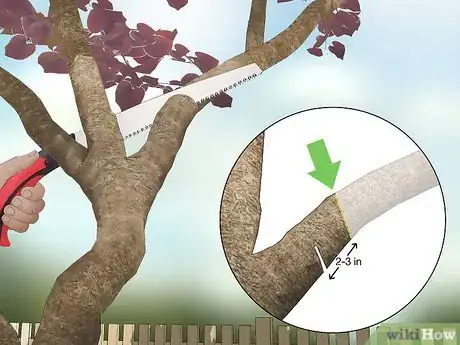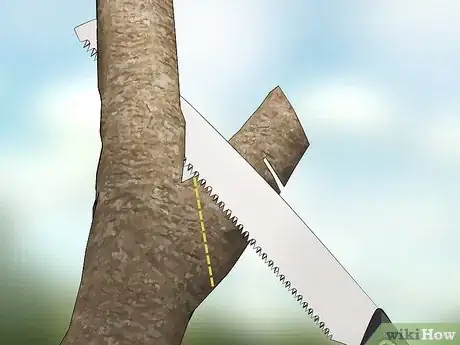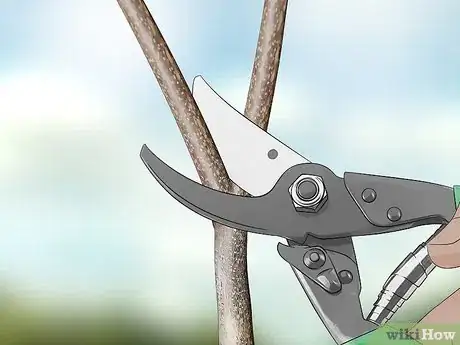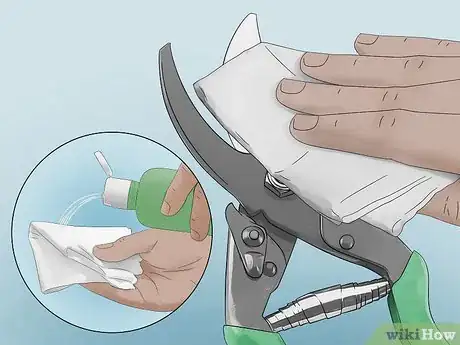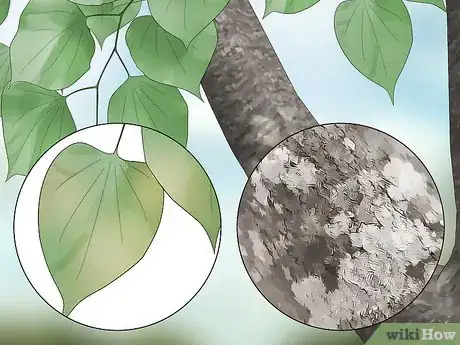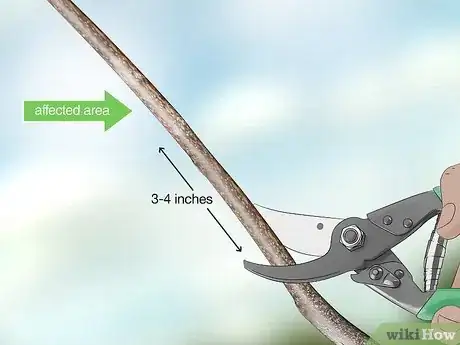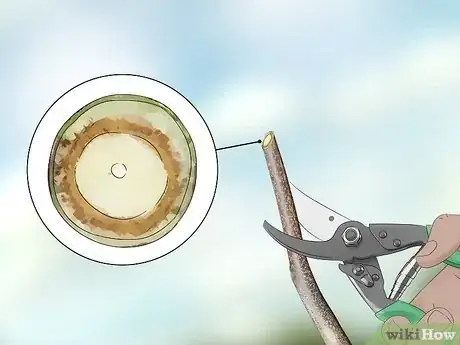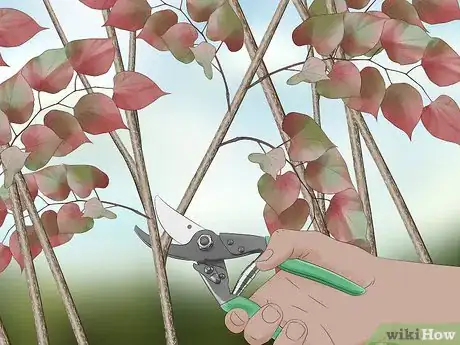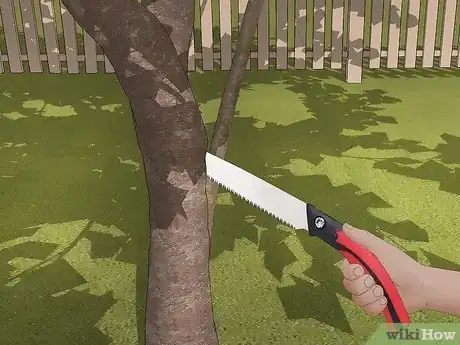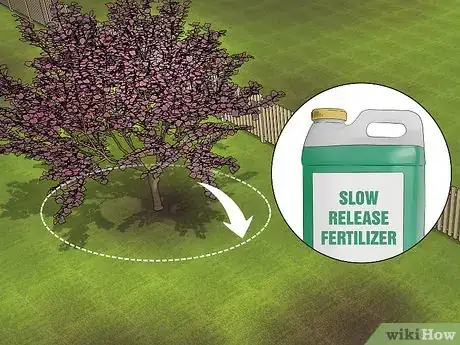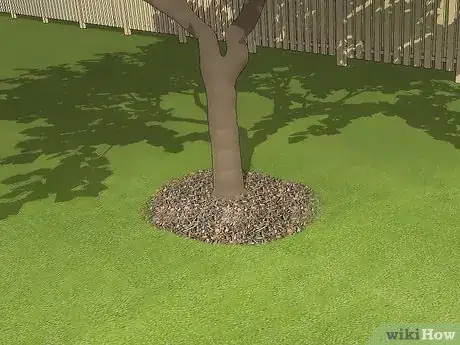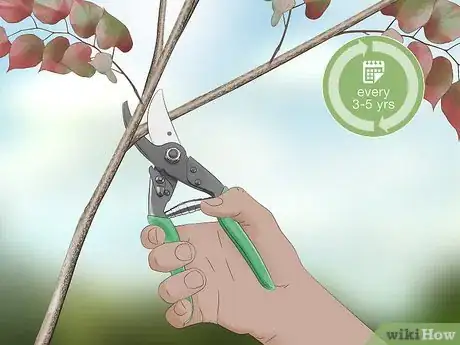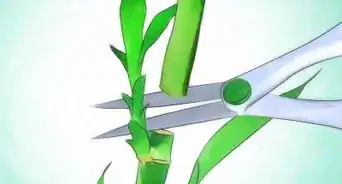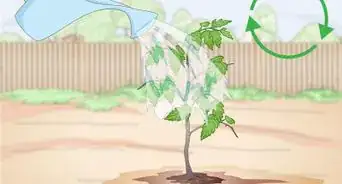X
This article was co-authored by wikiHow Staff. Our trained team of editors and researchers validate articles for accuracy and comprehensiveness. wikiHow's Content Management Team carefully monitors the work from our editorial staff to ensure that each article is backed by trusted research and meets our high quality standards.
This article has been viewed 49,715 times.
Learn more...
Redbud trees, or cercis canadensis, are a type of North American tree that bloom in the spring. They are low-maintenance as far as pruning goes. Once you prune out all the dead or diseased branches in the winter, you only need to do some structural pruning in the late spring or early summer.
Steps
Part 1
Part 1 of 3:
Learning the Basic Technique
-
1Make a shallow cut under the branch, next to the collar. Choose the branch that you want to cut off, then use a hand saw to make a shallow cut into the underside of the branch, 4 to 5 inches (10 to 13 cm) from the collar.[1]
- The collar is the swollen ring where the branch joins the trunk. When you cut in this area, the collar will release chemicals that will help heal the wound faster.
- This is only for thick branches. If the branch is thin enough to cut off in a single cut, chop it off right at the collar instead with pruning shears.
-
2Cut the branch off 2 to 3 inches (5.1 to 7.6 cm) from the shallow cut. Make sure that you are cutting to the outside of the shallow cut, not between the shallow cut and the collar. This way, then the branch falls down, it won’t rip the back off all the way; the bark will stop tearing at the shallow cut.[2]Advertisement
-
3Remove the rest of the branch, all the way down to the collar. Try not to cut into the collar, however, or the wound won’t heal properly. At the same time, don’t leave any wood sticking out of the collar either, otherwise it will become a breeding ground for pests.[3]
- You do not need to seal the cuts. Leaving the wound open will allow it to breathe and heal faster.
-
4Cut 1⁄4 inch (0.64 cm) above buds. Do not cut through a bud, as this can lead to disease or dieback. Instead, cut 1⁄4 inch (0.64 cm) above the bud. If there are multiple buds, choose 1 bud that’s facing in the direction you want the new branch to grow in.[4]
-
5Remove 1 of the branches from the V junction if the tree is young. Redbud trees have 2 branches that stem from the trunk; this is known as a V-shaped junction. Unfortunately, these can break off during harsh windy or icy conditions. Cutting 1 of these branches off will help reduce damage.[5]
- Cut your desired branch off, 4 to 5 inches (10 to 13 cm) above the junction.
- Cut the rest of the branch off 1⁄4 inch (0.64 cm) above the junction.
-
6Sanitize your tools with rubbing alcohol after each cut that you make. Spray or pour some rubbing alcohol onto the shears or saw, then wipe them clean with paper towels. You need to do this after each cut that you make, even if it is on the same branch.[6]
- If you don't sanitize your tools, you risk spreading the disease to your other trees (or to other branches on the same tree).[7]
- If you don’t have alcohol, use a solution of 1 part bleach and 10 parts water instead.
Advertisement
Part 2
Part 2 of 3:
Doing Winter and Spring Pruning
-
1Plan to prune dead or diseased branches in late winter or early spring. This is when the tree is dormant, so doing extensive pruning is fine. The tree flowers in the winter, so if you care about enjoying the flowers longer, prune the tree in the spring, after the flowers have fallen.[8]
- Try to prune before the sap starts to form, and this will prevent sticky messes. Sap usually forms around early to mid spring.[9]
- You don't need to do any other type of pruning at this time. Things like thinning and shaping are considered to be structural pruning, and are best left for the summer.
-
2Learn how to identify cankers and Verticillium wilt. Redbud trees are prone to other diseases, but these 2 require that you prune the tree immediately; do not wait. Even if a branch looks dead, but you aren’t certain if it is diseased, you should still treat it as one; it is better to be safe than sorry.
- Cankers: look for brown, wilting leaves and cankers on the branches. Dark pits with black centers are another sign.
- Verticillium wilt: look for brown or yellowing leaves and lack of new, healthy leaves. More severe cases may include dead or dying branches.
-
3Cut at least 3 to 4 inches (7.6 to 10.2 cm) below the affected area. There is no way to chemically treat a canker or Verticillium wilt, so you have to cut the branch off. To prevent the fungus or disease from spreading, cut it at least 3 to 4 inches (7.6 to 10.2 cm) below the canker.[10]
-
4Look for healthy wood under the cut, then prune more if needed. Sometimes, the disease spreads further along the branch than what is visible on the outside. If you just pruned off the branch, and the exposed wood still looks dead, the disease is still present. Cut the branch back by another 3 to 4 inches (7.6 to 10.2 cm).
- If you don’t cut all of the dead or diseased wood off, the infection will continue to spread. In more severe cases, it may kill the entire tree.
-
5Leave branches that have recently wilted. Just because there's nothing growing on a branch at the moment does not necessarily mean that it is dead. Give it a few weeks, or wait until the next spring season before making your judgement.[11]
- If the branch blooms, then it is both alive and healthy, and does not need to be pruned.
- If the branch has been dead for several years or does not bloom the following spring, cut it off.
Advertisement
Part 3
Part 3 of 3:
Doing Summer Pruning
-
1
-
2Start pruning with any crisscrossing or crowded branches. Remove the inward-growing branches and leave only the ones that point towards the outside of the tree. This will help clear up some clutter within the tree’s canopy and allow for both air circulation and light penetration.[14]
- Air and light are both important as they can reduce the growth of mold, bacteria, and pests. The light will also allow the leaves to photosynthesize.
-
3Remove the lower branches, if desired. This is purely for aesthetic reasons. Take a look at your tree, and note the space between the ground and the lowest branches. Do the branches get in the way of anything, like porches, swings, etc.? If so, prune them off![15]
- Only do 1 or 2 branches each year, otherwise you’ll shock the tree. Keep pruning yearly until you remove your desired number of branches.
- The younger the tree is, the more effective this will be. It is still possible for older trees, however.
-
4Apply a slow-release fertilizer around the tree’s drip line. A fertilizer that is formulated for trees and shrubs will do just fine here. How much fertilizer you use depends on the format (granular or liquid) and the brand; read the instructions on the package.[16]
- Read the instructions that came with your fertilizer to find out if and when you should water it.
- The drip line is the span of the tree's canopy. Take a look at where the shadow lands when the sun is directly above your tree; that is the drip line.
- Plan to reapply the fertilizer every 6 weeks during the spring, until summer begins.[17]
-
5Cover the soil around the tree with mulch. Begin applying the mulch about 6 inches (15 cm) from the base of the trunk, and extend it out to just past the drip line. If the instructions that came with the fertilizer tell you to water it after applying the mulch, then do so now.[18]
- When reapplying the fertilizer, just move the mulch aside, add the fertilizer, then cover it back up with mulch again.
- If you can't move the mulch aside to reapply the fertilizer, just add the fertilizer on top of the mulch. Double the amount to ensure that it penetrates through the soil.
-
6Do additional summer pruning every 3 to 5 years. Redbud trees are low-maintenance, so after the first 3 years, you only need to prune the tree every 3 to 5 years afterwards. Keep in mind that how often you do this will also depend on the tree’s health and growth rate.[19]
- For example, if the tree gets cankers or dead wood, then don’t wait 3 to 5 years to cut the branch off. Do it immediately.
- This is only for the pruning discussed in this section. You should do the winter pruning each year.
-
7Trim off suckers and water sprouts every year in the summer. Suckers are vertical stems that grow from the ground, near the base of the tree. They won’t turn into new trees, and only take away nutrients. Water sprouts are similar, but they grow from the tree’s base.[20]
- Trim water sprouts as close to the base of the tee as you can. In order to reach the base of the suckers, you may actually have to dig into the soil.
Advertisement
Things You'll Need
- Hand saw
- Heavy-duty pruning shears
- Gardening gloves
- Ladder, if needed
- Rubbing alcohol or bleach
- Fertilizer
- Mulch
References
- ↑ https://www.bhg.com/gardening/trees-shrubs-vines/care/how-to-prune-trees/
- ↑ https://www.bhg.com/gardening/trees-shrubs-vines/care/how-to-prune-trees/
- ↑ https://www.bhg.com/gardening/trees-shrubs-vines/care/how-to-prune-trees/
- ↑ https://www.bhg.com/gardening/trees-shrubs-vines/care/how-to-prune-trees/
- ↑ https://www.bhg.com/gardening/trees-shrubs-vines/care/how-to-prune-trees/
- ↑ https://hgic.clemson.edu/factsheet/redbud/
- ↑ https://www.treehelp.com/redbud/
- ↑ https://www.wildflower.org/expert/show.php?id=10193
- ↑ http://www.hawkslandscape.com/redbud-pruning-winter-care-and-fertilizing/
- ↑ https://www.treehelp.com/redbud/
- ↑ https://www.treehelp.com/redbud/
- ↑ https://www.bartlett.com/resources/Plant-Health-Care-Recommendations-for-Redbud.pdf
- ↑ http://www.hawkslandscape.com/redbud-pruning-winter-care-and-fertilizing/
- ↑ http://www.hawkslandscape.com/redbud-pruning-winter-care-and-fertilizing/
- ↑ http://www.hawkslandscape.com/redbud-pruning-winter-care-and-fertilizing/
- ↑ https://hgic.clemson.edu/factsheet/redbud/
- ↑ https://hgic.clemson.edu/factsheet/redbud/
- ↑ https://hgic.clemson.edu/factsheet/redbud/
- ↑ http://www.hawkslandscape.com/redbud-pruning-winter-care-and-fertilizing/
- ↑ http://www.hawkslandscape.com/redbud-pruning-winter-care-and-fertilizing/
About This Article
Advertisement

